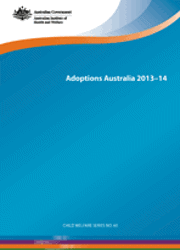Summary
Adoption numbers remained low
The 317 adoptions considered to have been finalised in 2013-14 are the lowest annual number on record-a fall of 9% from the 348 adoptions in 2012-13, and 76% from the 1,294 adoptions recorded 25 years earlier in 1989-90.
The long-term fall in numbers can, in part, be attributed to legislative changes, such as the increased use of alternative legal orders in Australia, and improvements in local adoption practices in countries of origin, as well as to broader social trends and changing social attitudes, which have made it easier for children to stay with their family or in their country of origin.
More than a quarter of all adoptions were carer adoptions
Unlike other types of adoption that have declined over time, the 89 adoptions by known carers, such as foster parents, in 2013-14 was the highest number of this type of adoption in the previous decade-more than triple the 29 such adoptions in 2004-05, and a continued rise from the previous high of 81 in 2012-13. Carer adoptions represented more than a quarter (28%) of all finalised adoptions in 2013-14.
Intercountry processing times stabilised
The median length of time to complete an intercountry adoption had been increasing each year since data were first reported for 2007-08, but in 2013-14 it remained stable at 5 years. This can be attributed to an increasing proportion of adoptees coming from countries of origin with shorter median processing times, such as Taiwan, and a decreasing proportion coming from countries with longer waiting periods, such as China and Thailand.
In 2013-14, placements from Taiwan had the shortest median processing time at just over 3 years (40 months), while placements from China had the longest processing time at almost 8 years (94 months).
Taiwan continued to be the main country of origin for overseas adoptions
The number of finalised intercountry adoptions has declined for most countries of origin in recent years. However, the number from Taiwan has increased substantially-from 3 adoptions in 2003-04 to 41 in 2013-14. Revised data indicate that Taiwan has been the main country of origin for overseas adoptions since 2011-12. With 36% of all intercountry adoptions in 2013-14, Taiwan has overtaken the Philippines and China, which have shared this position since 2003-04.
Children in local adoptions tended to be younger
Although the majority (72%) of children adopted from overseas were aged under 5, changes in intercountry programs and the population of children considered to be available for adoption has led to a decline in the proportion of infants aged under 12 months—from a peak of 47% of all intercountry adoptions finalised in 2005–06 to just 14% in 2013–14.
In contrast, all children who were the subject of a finalised adoption in 2013–14 were aged under 5, and almost half (48%) were infants under 12 months.



